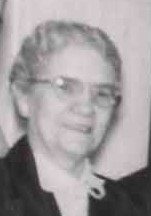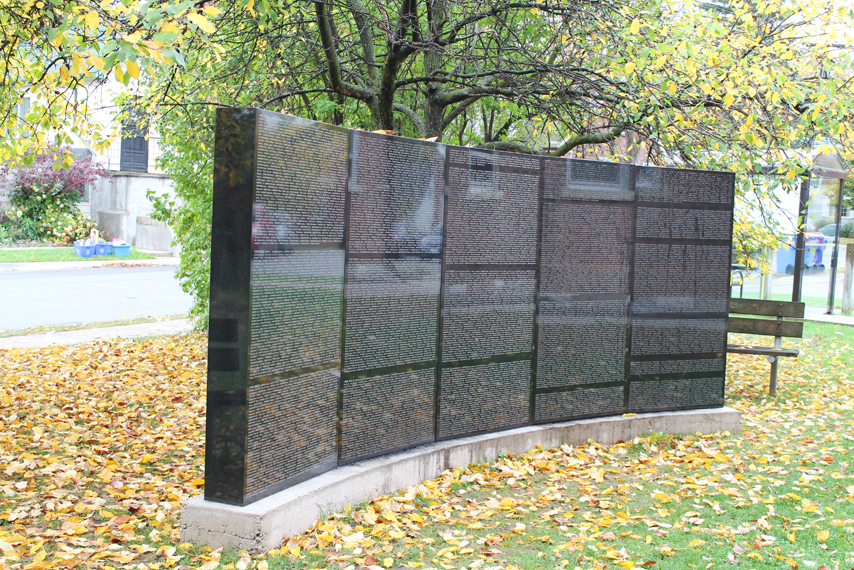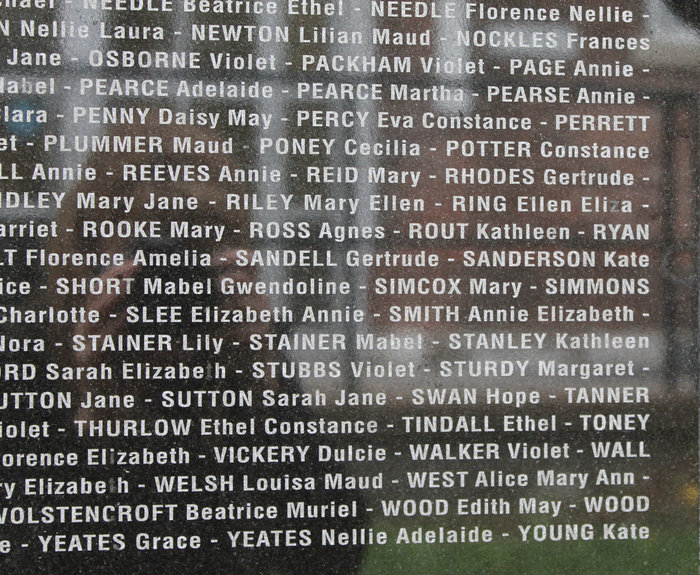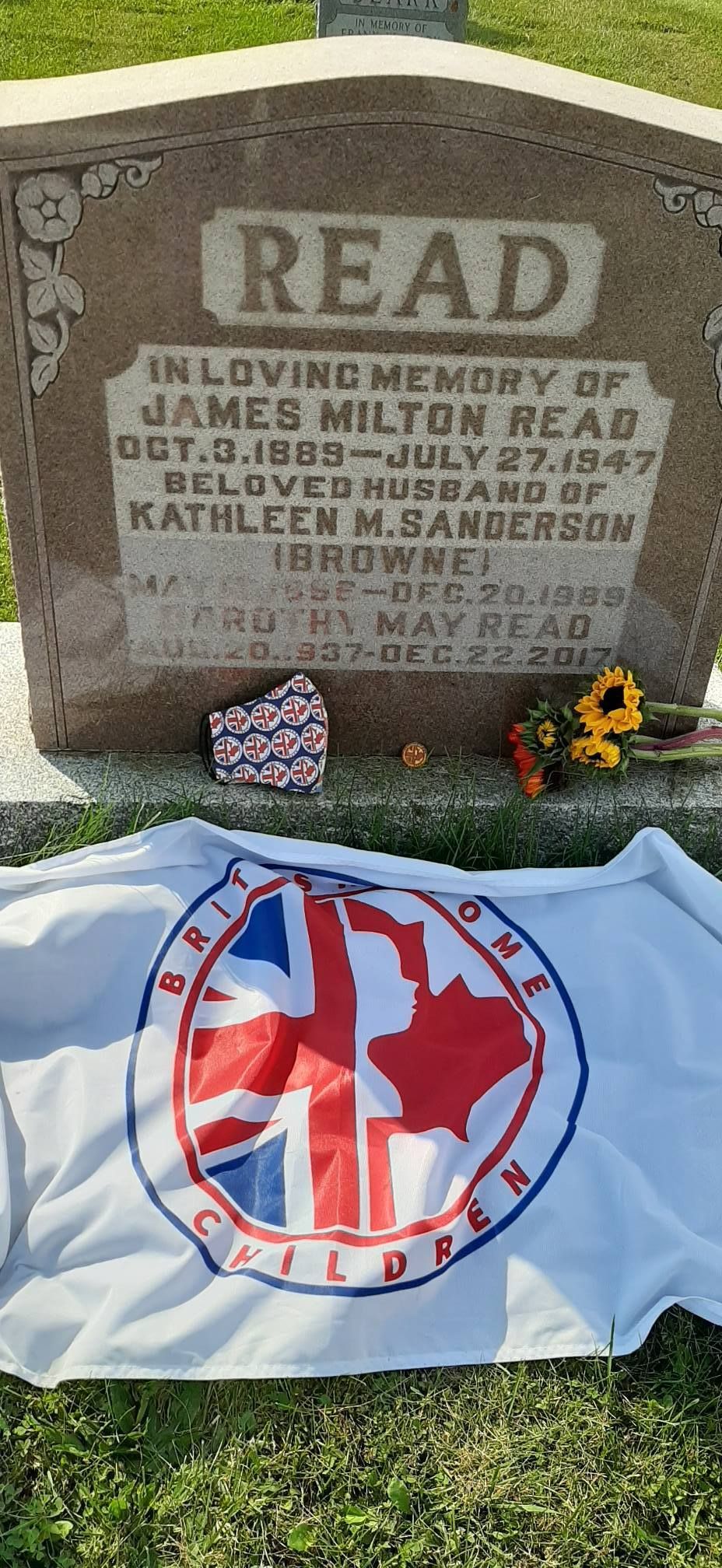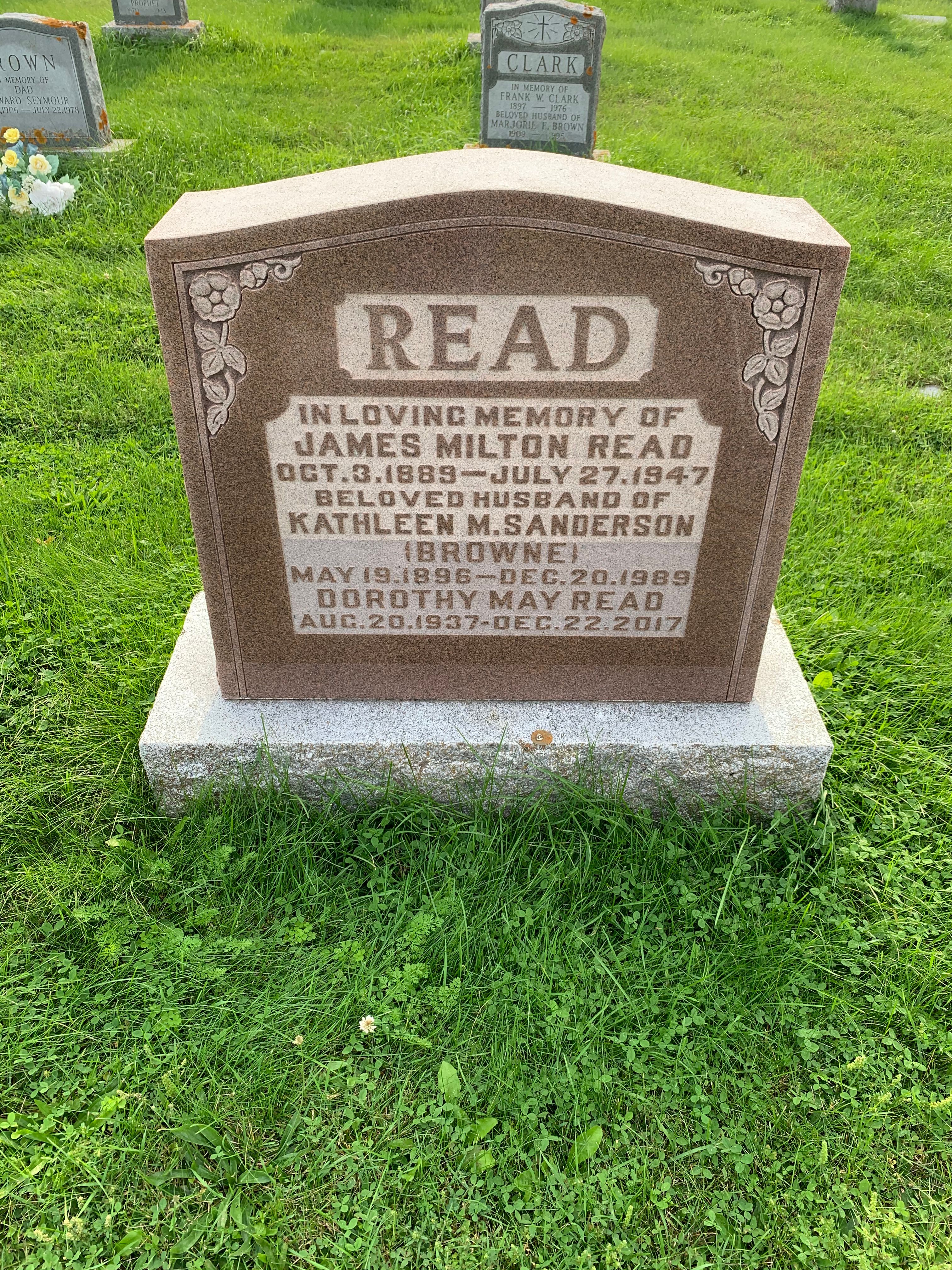Katie was the daughter of Alfred Richard Sanderson (Memorial # 237221490) and his wife Kate Daley of London England. She was the Grandaughter of Richard Daley and his wife Mary Bray. Katie's father Richard died in 1897 in London, England. Katie's parents had been married on July 14, 1895. Katie was their first child and may have been their only child as her father died when she was about 10 months old.
In 1907 Katie was brought to Canada by the Dr. Barnardo's homes in London England. She had been taken in to care by Barnardo's and was a British Home Child. In Canada Katie was unofficially adopted by David Wilson Elder and his wife Mary. Katie was treated just like a daughter and very well looked after. She was spared the harsh treatment that many Home Children suffered. Katie would become a nurse.
Katie and James adopted a child, Dorothy May Read. She was born on Aug 20, 1937. Dorothy was a special needs child and Katie provided excellent care for her. Katie's first husband was Frederick Browne
Home Children (1869-1930)
Item Display
Return to results | Search | Search Help
Surname: SANDERSON
Given Name: Kate
Age: 11
Sex: F
Ship: Kensington
Year of Arrival: 1907
Departure Port: Liverpool
Departure Date: 11 July 1907
Arrival Port: Quebec
Arrival Date: 20 July 1907
Party: Dr Barnardo's
Destination: Toronto, Ontario
Comments: See also C-4716 and T-527
Source: Library and Archives Canada
Reference: RG76 C 1 a
Microfilm: T-491
Type of Record: Passenger Lists
The British Home Children
Approximately 125,000 children were sent to Canada from England, under the Child Immigration scheme from 1833-1939. These boys and girls ranged in age from toddlers to adolescents and were all unaccompanied by their parents even though only one-third of them were orphans. Most emigrant children came from respectable, if poor, families bound by strong ties of affection and support. Most of these children were brought to institutions such as Barnardo's as a last resort, when a crisis, or repeated crises – desertion or death of a parent, illness, unemployment – prevented a family and its network of kin from coping. Although some families regarded admission as a temporary expedient, the rescue homes carefully controlled or even discouraged further contact between all children and their relatives for fear that the children would be tempted to return to homes. Once in care, most of these families never saw these children again. Siblings in care in Britain were often separated from their families and each other. Siblings were often separated from each other when they were sent to Canada. Most never saw each other again. Many spent their lives trying to identify their parents and find their siblings and most were unsuccessful.
The Barnardo homes were set up in Canada and England by Dr. Thomas Barnardo for homeless or destitute English children. Peterborough, Ontario emerged as the main Canadian distribution centre for Barnardo children from 1889 to 1922. The Hazelbrae Barnardo Home in Peterborough was built by Thomas Belcher in 1872 for Alexander Smith. It was renovated in 1883 by George and Margaret Cox and donated to Dr. Barnardo. In 1923 it was destroyed by fire.
Although Dr. Barnardo's organization was not the only one involved in the immigration of children to Canada, he became the most influential figure in child migration of the last half of the nineteenth century. His crusade to 'rescue children from the streets' was one the best known social interventions in the last half of the nineteenth century. Dr. Barnardo himself, died in 1905. When he died, there were nearly 8,000 children in the 96 residential homes he had set up. Around 1300 of these children had disabilities. More than 4,000 children were boarded out, and 18,000 had been sent to Canada and Australia. After his death, the Barnardo organization would continue to run in his name and is still an active children's charity organization in England today.
Of the 125,000 children sent to Canada, 20,000 came from the Barnardo Homes. There were many other organizations involved in the migration of children out of England. Some of the better known were Annie Macpherson, Maria Rye, Fegan Homes, Dr. Stephenson and the National Children's Home. Annie Macpherson and Maria Rye pioneered child migration to Canada in 1869. Emigration seemed the only way to break the tragic cycle of grinding poverty that was so rampant in the Victorian years. Dr. Barnardo began migration of children in about 1872 through Macpherson's organisation. By 1881 Dr. Barnardo established himself in his own right in the migration of children by the acquisition of a receiving home in Toronto, Ontario, Canada and then the Hazlebrae home in Peterborough, Ontario, Canada. He would go on to set up "receiving homes" across Canada, including a large training farm in Russel Manitoba. There he would send the older boys to be trained as farmers with hopes they would acquire land form the Dominions Land Act and become farmers in their own right.
Once in Canada, the children were not usually adopted into new families, but rather were taken into households to be trained and to work as indentured agricultural labourers and domestic servants until about the age of 18. The poor choice of placements in Canada and the subsequent lack of supervision left these children vulnerable to being exploited and abused - and many were. The organizations sending these children never adequately took into consideration the welfare and safety of the children in their charge. Sensational stories of isolated incidents of criminal and immoral behaviour committed by home children, exploitation in the press and propaganda spread about these children by influential people of the time raised Canadians' fears about the character of the young emigrants. As much as they feared these children, Canadians needed the cheap help on their farms and in their homes. These organizations, including Barnardo's in the later years, quickly lost sight of the mission of rescue as the need increased. The British Child Care organizations, who professed motives of providing these children with a better life, developed other ignoble and pecuniary motives. As Canadian's need for these children, despite their fears increased - the organizations could not immigrate these children into this country fast enough. The organizations in effect rid themselves of an unwanted segment of their society and profited when they in effect "sold" these children to Canadian farmers.
Katie was the daughter of Alfred Richard Sanderson (Memorial # 237221490) and his wife Kate Daley of London England. She was the Grandaughter of Richard Daley and his wife Mary Bray. Katie's father Richard died in 1897 in London, England. Katie's parents had been married on July 14, 1895. Katie was their first child and may have been their only child as her father died when she was about 10 months old.
In 1907 Katie was brought to Canada by the Dr. Barnardo's homes in London England. She had been taken in to care by Barnardo's and was a British Home Child. In Canada Katie was unofficially adopted by David Wilson Elder and his wife Mary. Katie was treated just like a daughter and very well looked after. She was spared the harsh treatment that many Home Children suffered. Katie would become a nurse.
Katie and James adopted a child, Dorothy May Read. She was born on Aug 20, 1937. Dorothy was a special needs child and Katie provided excellent care for her. Katie's first husband was Frederick Browne
Home Children (1869-1930)
Item Display
Return to results | Search | Search Help
Surname: SANDERSON
Given Name: Kate
Age: 11
Sex: F
Ship: Kensington
Year of Arrival: 1907
Departure Port: Liverpool
Departure Date: 11 July 1907
Arrival Port: Quebec
Arrival Date: 20 July 1907
Party: Dr Barnardo's
Destination: Toronto, Ontario
Comments: See also C-4716 and T-527
Source: Library and Archives Canada
Reference: RG76 C 1 a
Microfilm: T-491
Type of Record: Passenger Lists
The British Home Children
Approximately 125,000 children were sent to Canada from England, under the Child Immigration scheme from 1833-1939. These boys and girls ranged in age from toddlers to adolescents and were all unaccompanied by their parents even though only one-third of them were orphans. Most emigrant children came from respectable, if poor, families bound by strong ties of affection and support. Most of these children were brought to institutions such as Barnardo's as a last resort, when a crisis, or repeated crises – desertion or death of a parent, illness, unemployment – prevented a family and its network of kin from coping. Although some families regarded admission as a temporary expedient, the rescue homes carefully controlled or even discouraged further contact between all children and their relatives for fear that the children would be tempted to return to homes. Once in care, most of these families never saw these children again. Siblings in care in Britain were often separated from their families and each other. Siblings were often separated from each other when they were sent to Canada. Most never saw each other again. Many spent their lives trying to identify their parents and find their siblings and most were unsuccessful.
The Barnardo homes were set up in Canada and England by Dr. Thomas Barnardo for homeless or destitute English children. Peterborough, Ontario emerged as the main Canadian distribution centre for Barnardo children from 1889 to 1922. The Hazelbrae Barnardo Home in Peterborough was built by Thomas Belcher in 1872 for Alexander Smith. It was renovated in 1883 by George and Margaret Cox and donated to Dr. Barnardo. In 1923 it was destroyed by fire.
Although Dr. Barnardo's organization was not the only one involved in the immigration of children to Canada, he became the most influential figure in child migration of the last half of the nineteenth century. His crusade to 'rescue children from the streets' was one the best known social interventions in the last half of the nineteenth century. Dr. Barnardo himself, died in 1905. When he died, there were nearly 8,000 children in the 96 residential homes he had set up. Around 1300 of these children had disabilities. More than 4,000 children were boarded out, and 18,000 had been sent to Canada and Australia. After his death, the Barnardo organization would continue to run in his name and is still an active children's charity organization in England today.
Of the 125,000 children sent to Canada, 20,000 came from the Barnardo Homes. There were many other organizations involved in the migration of children out of England. Some of the better known were Annie Macpherson, Maria Rye, Fegan Homes, Dr. Stephenson and the National Children's Home. Annie Macpherson and Maria Rye pioneered child migration to Canada in 1869. Emigration seemed the only way to break the tragic cycle of grinding poverty that was so rampant in the Victorian years. Dr. Barnardo began migration of children in about 1872 through Macpherson's organisation. By 1881 Dr. Barnardo established himself in his own right in the migration of children by the acquisition of a receiving home in Toronto, Ontario, Canada and then the Hazlebrae home in Peterborough, Ontario, Canada. He would go on to set up "receiving homes" across Canada, including a large training farm in Russel Manitoba. There he would send the older boys to be trained as farmers with hopes they would acquire land form the Dominions Land Act and become farmers in their own right.
Once in Canada, the children were not usually adopted into new families, but rather were taken into households to be trained and to work as indentured agricultural labourers and domestic servants until about the age of 18. The poor choice of placements in Canada and the subsequent lack of supervision left these children vulnerable to being exploited and abused - and many were. The organizations sending these children never adequately took into consideration the welfare and safety of the children in their charge. Sensational stories of isolated incidents of criminal and immoral behaviour committed by home children, exploitation in the press and propaganda spread about these children by influential people of the time raised Canadians' fears about the character of the young emigrants. As much as they feared these children, Canadians needed the cheap help on their farms and in their homes. These organizations, including Barnardo's in the later years, quickly lost sight of the mission of rescue as the need increased. The British Child Care organizations, who professed motives of providing these children with a better life, developed other ignoble and pecuniary motives. As Canadian's need for these children, despite their fears increased - the organizations could not immigrate these children into this country fast enough. The organizations in effect rid themselves of an unwanted segment of their society and profited when they in effect "sold" these children to Canadian farmers.












